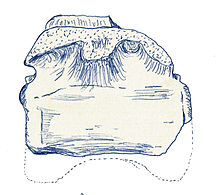Ornithomimoides
| Ornithomimoides Temporal range: Late Cretaceous,
| |
|---|---|

| |
| Illustration of a partial vertebra of O. mobilis | |
| Scientific classification | |
| Kingdom: | Animalia |
| Phylum: | Chordata |
| Clade: | Dinosauria |
| Clade: | Saurischia |
| Clade: | Theropoda |
| Family: | †Abelisauridae |
| Genus: | †Ornithomimoides Huene, 1932 vide Huene and Matley, 1933 |
| Type species | |
| †Ornithomimoides mobilis von Huene and Matley, 1933
| |
| Other species | |
| |
| Synonyms | |
| |
Ornithomimoides ("bird mimic-like") is a dubious genus of theropod dinosaur, from the Late Cretaceous (Maastrichtian stage, sometime between 70 and 66 mya) Lameta Formation of India.[1] Two species have been identified, the type species O. mobilis and O. barasimlensis, were named by von Huene in 1932[2] and were described by Matley in 1933[3] though they are known only from isolated vertebrae. O. barasimlensis is known from five dorsal vertebrae, and O. mobilis from four smaller vertebrae, found at the same location. It is possible that, based on two reviews, published in 1999 and 2004 respectively, Ornithomimoides may have been an abelisaur, which may have measured between 6.2 metres (20 ft) and 9 metres (30 ft) in length.[4][5]
See also[]
- Timeline of ceratosaur research
References[]
- ^ "Ornithomimoides in the Dinosaur Encyclopaedia at Dino Russ's Lair". Archived from the original on 2008-05-28. Retrieved 2011-04-10.
- ^ von Huene. (1932). Die fossile Reptil-Ordnung Saurischia, ihre Entwicklung und Geschichte. Monog. Geol. Pal. 4 (1) pts. 1 and 2, viii + 361 pp.
- ^ Huene and Matley. (1933). The Cretaceous Saurischia and Ornithischia of the central provinces of India. Pal. Indica 21 1-74, 33 figs., 24 pls.
- ^ Novas and Bandyopaphyay. (1999). New approaches on the Cretaceous theropods from India. VII International Symposium on Mesozoic Terrestrial Ecosystems, abstracts.
- ^ Novas, Agnolin and Bandyopadhyay. (2004). Cretaceous theropods from India: A review of specimens described by Huene and Matley (1933). Rev. Mus. Argentino Cienc. Nat., n.s. 6(1): 67-103.
Categories:
- Late Cretaceous dinosaurs
- Dinosaurs of India and Madagascar
- Ceratosaurs
- Fossil taxa described in 1933
- Taxa named by Friedrich von Huene
- Taxa named by Charles Alfred Matley
- Nomina dubia
- Theropod stubs













